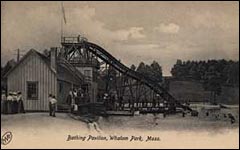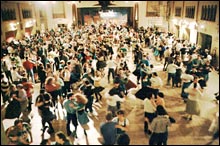Mat Lindstedt was a typical 12-year-old growing up in San Jose during the 1970s. He spent his summers braving the runaway mine ride, paddling the Indian war canoes, and riding the lazy burros at Frontier Village amusement park.

Riding an endangered species.
Photo: iStockphoto
But Lindstedt’s summers changed in 1980, when the owners of Frontier Village decided the park’s 33 acres would fetch them far more dollars in the San Jose real-estate market than it ever would as a kiddie kingdom. The park never stood a chance, and closed its gates for good.
“It was heart-wrenching,” Lindstedt says today. “The park sat there all closed up. They auctioned off some of the stuff, but … the things that were left were just rotting away. It was kind of sad to see this place all decrepit and failing.”
Today, a good portion of Frontier Village is a city park — not a bad use of the land, in Lindstedt’s opinion. But you can hear the cringe in Lindstedt’s voice as he reports that the other half is home to a large condo complex. Worst of all? The developers had the nerve to call their development “Frontier Village.”
It’s not an uncommon story. Running a small, regional amusement park — defined by the International Association of Amusement Parks and Attractions as one that draws fewer than 500,000 visitors a year — is no easy task. Insurance costs are high. Competition from larger parks is intense. Attendance traditionally dips significantly once the summer ends. So it’s no surprise that owners often sell their parks to developers willing to pay big money. The problem comes when land that included some amount of open space is swallowed by shopping centers, strip malls, and high-density subdivisions.
Jim Futrell, historian with the National Amusement Park Historical Association, says he’s seen more amusement park closings in the last two to three years than in the previous 25. The number of active amusement parks in the U.S. is about 600, according to the IAAPA, and half of these are small, regional parks. In 2005, the country’s parks generated about $11.2 billion in revenues from 335 million visitors.
Those numbers actually increased from the previous years, but still the closings come. Futrell doesn’t have any statistics on the fate of closed parks — he doesn’t know how many became strip malls or condominium developments — but he’s familiar enough with the industry to know that’s the fate of many.
Those concerned about this growing trend, a mixed crew consisting of nostalgia-driven amusement park junkies, neighbors concerned with traffic resulting from new businesses and housing, and open-space advocates, say there must be a better use of old amusement parks. Many of them are willing to fight for it — with mixed results.
Consider the fates of two other independent amusement parks. One appears destined, despite the efforts of a group of citizens, to become a gated housing community. The other has become a busy public recreation area, complete with reminders of the destination it once was. Why the difference? It may be as simple as the land upon which the parks sit.
A Real Roller Coaster
Since 2001, Allyson Bowen has fought to save Whalom Park, a more than 100-year-old facility in Lunenburg, Mass. Bowen’s family had run the park since 1935, but in the late 1990s, an uncle sold his shares in the Whalom Park Amusement Company. This left the Bowen family with control over just 41 percent of the enterprise.
Citing the costs of operating and dwindling profits, the company shut Whalom down at the end of the 2000 summer season. In 2005, a developer signed an option on the property, and is planning to build an upper-end gated community of 240 condominiums called Emerald Place on the site.

Historic postcard of Whalom Park, built in 1893.
Bowen, who no longer lives in the area, has spent long hours rallying support for the park, encouraging donors to raise money through her website. She originally planned to use the money to create an investment group to buy back the land, but that plan failed. Bowen next worked with Lunenburg residents to convince the town’s planning board to raise more than $5 million to reclaim the park’s land through eminent domain. That effort, too, failed, with the board voting in support of the condo plan.
Now, Bowen is ready to concede. She says she never expected to reopen Whalom Park in its old form, saying that was unfeasible. But she did hope to turn the site into a public park and recreation area, repairing and refurbishing some of the old buildings, including a vintage roller rink and the building that housed Whalom’s antique carousel. That, Bowen says, would be a far better, and friendlier, use of the land than a gated community.
“People are telling me now that this is over, you can at least move on,” Bowen said. “Yeah, that’s great. But the issue really isn’t my issue anymore. It’s the town of Lunenburg’s issue. I live in New York City now, so I have Central Park. It’s the people in the town who have lost their amusement park and are going to have all this new housing come into their town. They’re about to lose their drive-in theater, too. They are losing the things that make people want to live in the town in the first place.”
The fight isn’t completely over. Four residents abutting the proposed site of Emerald Place have filed a lawsuit challenging the development, saying that the planning board did not act in the best interests of nearby residents when approving the project. Bowen, though, has little hope that the lawsuit will save Whalom.
“I think it gets to the point where you’re tilting at windmills, and that’s sad,” she said. “I knew eminent domain was a long shot. But turning Whalom into a public park could have worked, and it would have been such a better idea than bringing more housing to the area.”
Show Them That You Carousel
There is another option, though, for parks that face the wrecking ball, and it’s the one that the citizens in Lunenburg tried unsuccessfully: turning old amusement parks into public recreation areas. This allows the parks to retain their history, and places less of a strain on the land than condominiums or shopping centers. In fact, open space puts less stress on the land than even small amusement parks; no one would say, after all, that having crowds lining up in front of roller coasters or funhouses is a low-stress use of land.
The concept has worked well in Glen Echo, Md., home of Glen Echo Park, which operated as an amusement park from the early 1900s through the 1968 season. That year, its owners announced that they were shutting the facility. Three years later, the National Park Service took over ownership, shipped out most of the rides, and turned the site into a public recreation center.

Glen Echo Park’s Spanish Ballroom
comes alive every weekend.
Photo: NPS/Sally Ehrlich Hoffmann
Today, the nonprofit Glen Echo Park Partnership for Arts and Culture runs the park. Remnants of its past include a restored carousel, an arcade building, and a large Spanish ballroom. Groups such as Glen Echo Dance and Movement, Discovery Creek Children’s Museum, and The Puppet Co. hold classes and performances on the grounds.
Katey Boerner, executive director of the Glen Echo partnership, agrees that having a public park and tribute to Glen Echo Park’s past is preferable to staring up at rows of townhouses or yet another Bed Bath & Beyond. A major reason the land didn’t fall into the hands of residential or commercial developers, though, was probably its location, Boerner says. A bit of luck was involved: The amusement park sat on the Potomac palisades near Bethesda, Md. It’d take either amazing guile or truly terrible planning for anyone to suggest putting up condos on such a historic piece of land.
About 500,000 visitors stop by Glen Echo every year, a testament to the strong draw of open space, water views, and history. “There was definitely an environmental reason to keep this a public open space,” Boerner said. “The goal was never to save the rides of the old park, but to save the land and some of the historic older buildings. I think this has been a wonderful public use of this land. I can’t think of a better use for it.”
In the end, the land may be what made the difference between the fates of Whalom Park and Glen Echo. Open-space proponents across the country might consider researching the sites on which closed amusement parks — and even still functioning ones — sit. These are prime parcels whose future is too often decided by economics alone.
Back in San Jose, Lindstedt is doing his part to keep at least the memories of Frontier Village alive with a website he created and runs. Every year, he attends a picnic at the former grounds of the park with other fans, who reminisce about the days when the likes of Tonto and Lorne Green dropped by. Unfortunately, memories are all this crowd of devotees has left. “I think I’ll always miss this park,” Lindstedt says. “And I really don’t like those condos at all.”



